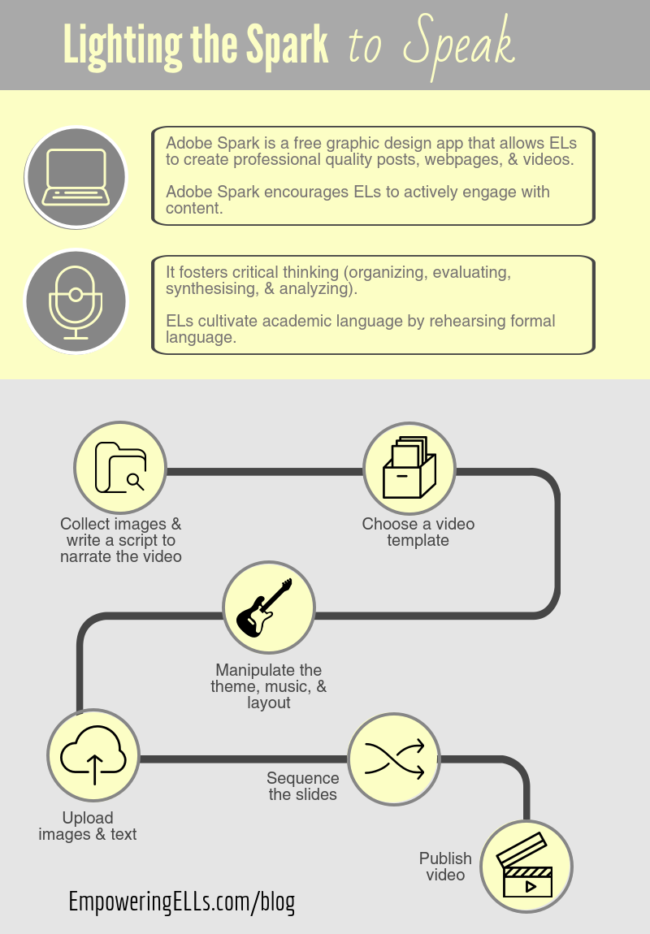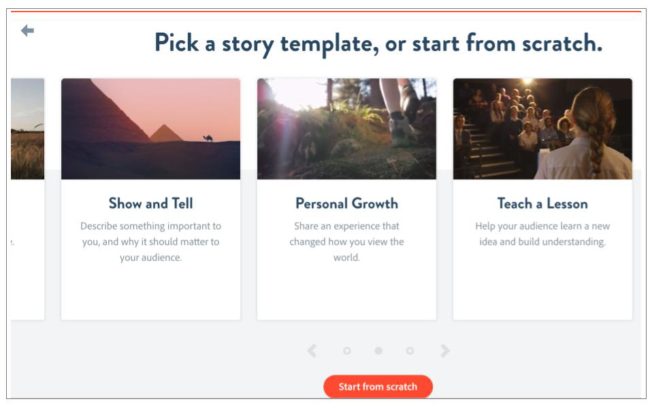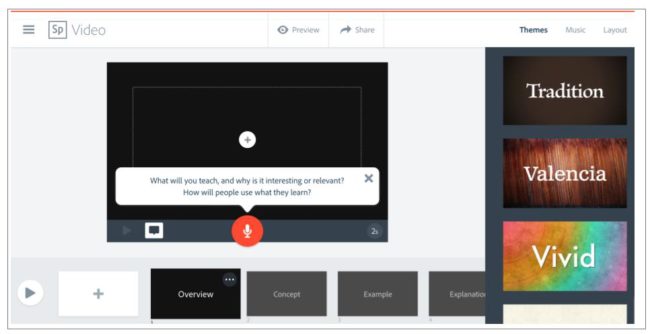This article about using Express (formerly Adobe Spark) to differentiate speaking tasks for ELs is part X of the Transforming Instruction Through Technology series.
When I saw the benefits of integrating technology to enhance reading and writing instruction, I began to explore how tech can transform ELs’ speaking skills. Coincidentally, Tom Daccord from EdTechTeacher recently provided a 4-day professional development on meaningful tech integration at my school. Daccord introduced Adobe Express as program that invites students to creatively display students work while developing critical thinking skills.
What does Adobe Express do?
Adobe Express is a video-making program that allows students to communicate their thinking by stitching images, texts, and voice-recordings together into a professional video.
Because of these capabilities, I see Adobe Express like a digital canvas that serves several purposes. It:
- Increases content engagement: Adobe Express empowers ELs to synthesis content knowledge using multimedia resources.
- Promotes critical thinking: Students are required to organize, evaluate, and analyze ideas and images to communicate their message.
- Provides opportunities to rehearse academic language: The voice-recording aspect of Adobe Express and the presentation nature of the platform requires ELs to switch from social to academic language but provides a space for rehearsing language versus engaging in debates.
A Differentiation Case Study using Adobe Express
Creating Their Videos
Eager to have students explore these benefits, I encouraged the content teachers whom I co-teach with to use Adobe Express. Mr. D, a 7th grade humanities teacher, took up my invitation to integrate Adobe Express into his next assignment.
Mr. D wanted students to learn about the life experiences of hunters and gatherers. After students collected the information using a jigsaw, we explained that they needed to synthesize the information using Adobe Express. We set aside a few lessons for students to gather relevant images and draft a script for the video.
Then, students created an Adobe Express account and chose a video template to help them organize their central message. Students then manipulated the theme, music, and layout to customize their video.
Students then recorded their narration of each slide. For ELs with a strong accent or a soft voice, ask them to provide subtitles to scaffold understanding for the audience. Finally, they sequenced the slides in a logical order. When the students were ready, they published the video and sent the link to me and Mr. D. There’s also an option to download it to Google Drive.
Developing Academic Language
To develop the ELs’s academic language, I gave them sequence recount signal words they could use to transition from one idea to the next, such as “firstly”, “additionally”, and “even though”. I also recommended a list of verbs to use that were relevant to the content, such as “gather”, “locate”, and “collaborate”.
Surprise Ending: Ryan’s Success Story
I was confident that the Developing and Expanding ELs would benefit from the content engagement and language development of Adobe Express, but I didn’t know how Beginning ELs like Ryan would fare.
When Ryan enrolled in our school, his previous school reported that he was shy – so shy that he would only nod for “yes” and frown for “no”. In October, we realized that he was a selective mute student when he came to me and asked with mouse-size whisper, “Can I go to the library?” (He wanted to get new books for free voluntary reading time). That was the most I ever heard him speak.
As it turns out, Adobe Express was a perfect tool for students like Ryan because it built his confidence in presenting in front of a crowd. Ryan is selectively mute because he is deathly afraid of making mistakes. He avoids speaking in classroom discussions because his English couldn’t process the fast pace of words whirling around in classroom conversation. Additionally, a lack of opportunity to rehearse his speech crippled his confidence further.
However, Adobe Express sheltered Ryan as he engaged in the assignment. It carved out a space where Ryan was free to create and rehearse his speech until he felt comfortable enough to talk. We watched as he took his script, hugged his laptop close to his chest and record his speech in a hushed whisper. When he wasn’t satisfied, he recorded it again.
Ryan was finally speaking more than ever. On the day of the presentation, Ryan just stood up holding his laptop connected to the speakers, pushed play, and beamed a tiny crescent smile as his Adobe Express video played for the class.
As cheesy as it sounds, his classmates actually stood on their feet and gave him a standing ovation because it was the first time they too had heard Ryan speak so many words so well.
Months later, Ryan is still selectively mute, but at least his teachers now can offer him a tool when speaking is required. Adobe Express is like a teaspoon slowly filling up the cup of Ryan’s confidence. One day, when his confidence finally brims beyond the rim of shyness, he will be able to engage in open discussions without hiding behind rehearsed speeches.
Takeaways
In their book entitled ELL Frontiers: Using Technology to Enhance Instruction for English Learners, Parris, Estrada, and Hongisfeld suggest that when technology is successfully integrated, it affords ELs more opportunities to engage in activities that lead to academic achievement (2016).
Learning about Adobe Express was never the goal of our lesson – engaging with content, fostering creative thinking, and developing academic speaking skills was. And it was a resounding success.




